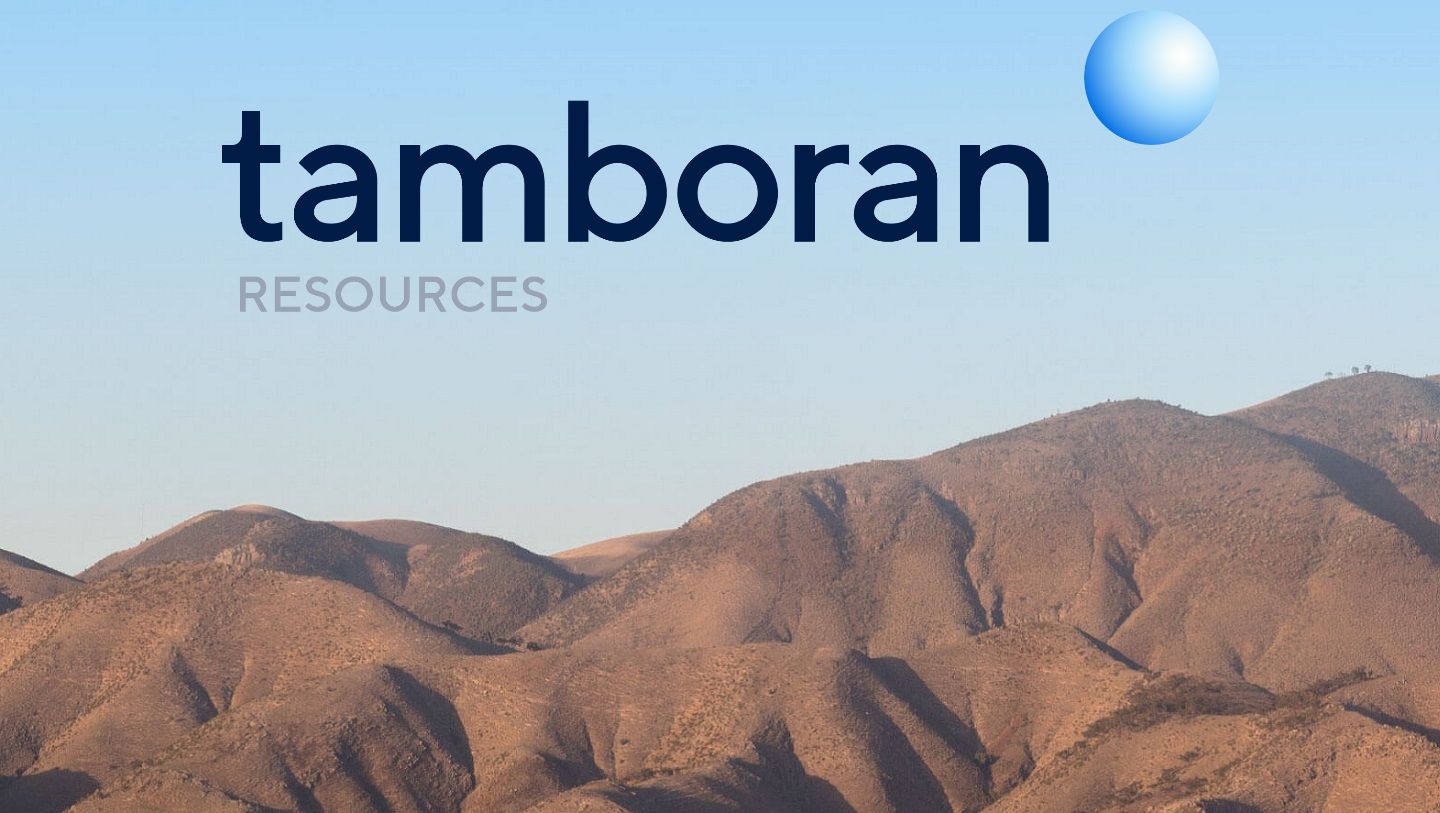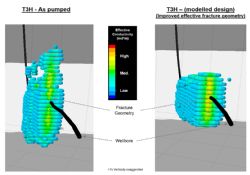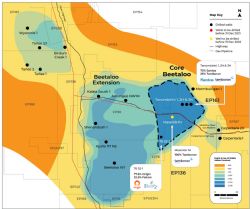 Operational Update - EP 161 Tanumbirini 2H and 3H Flow Rates
Operational Update - EP 161 Tanumbirini 2H and 3H Flow Rates
Sydney, Feb 1, 2022 AEST (ABN Newswire) - Tamboran Resources Limited ( ASX:TBN) announce that the Tanumbirini 2H ("T2H") and Tanumbirini 3H ("T3H") wells drilled in Northern Territory permit EP 161 have delivered gas to surface from the Mid-Velkerri "B" shale of the Beetaloo Sub-basin over an initial 30-day period.
ASX:TBN) announce that the Tanumbirini 2H ("T2H") and Tanumbirini 3H ("T3H") wells drilled in Northern Territory permit EP 161 have delivered gas to surface from the Mid-Velkerri "B" shale of the Beetaloo Sub-basin over an initial 30-day period.
The T2H well peaked at 4.0 mmscfd following a weather-related shut-in in mid-January 2022. The well has since stabilised at a 14-day average of 1.7 mmscfd over a 660-metre unoptimised fracture stimulated horizontal section (normalised at 2.6 mmscfd over 1,000-metres).
The T3H well peaked at 10.0 mmscfd following shut-ins for the same weather-related event and planned maintenance. The well has since stabilised at a 10-day average of 1.5 mmscfd over a 600-metre unoptimised fracture stimulated horizontal section (normalised at 2.5 mmscfd over 1,000-metres).
Incorporating the results from the Tanumbirini 1 vertical, T2H and T3H wells, Tamboran has developed an exclusive and independent model, using its own intellectual property, into optimisating effective fracture stimulation within the Mid-Velkerri "B" shale formation.
This modelling indicates that the Mid-Velkerri shale is capable of flowing gas in excess of 5 million standard cubic feet per day ("mmscfd") per 1,000-metre, which has been verified by independent subsurface expert, Subsurface Dynamics, Inc.
Tamboran plans to leverage its exclusive intellectual property to increase the size and maximise the efficiency of the fracture stimulation design within the Maverick 1H ("M1H") well, planned to be drilled during calendar year 2022. The M1H well will incorporate North American best practice unconventional drilling and fracture stimulation using Tamboran's proprietary design parameters.
The forward plan is to continue flow testing both T2H and T3H to gather further information on the Mid-Velkerri "B" shale formation.
Tamboran Resources Limited ( ASX:TBN) Managing Director and CEO, Joel Riddle, said:
ASX:TBN) Managing Director and CEO, Joel Riddle, said:
"We are encouraged by the initial flow rates, which support and validate Tamboran's Mid-Velkerri shale model. The flow tests have proven that the hydrocarbon system is working as expected and, similar to the evolution of the best North American shales, the next steps are to optimise the results with larger and more effective fracture stimulation designs, with well design completion techniques expected to have a considerable impact on the ultimate recovery of these wells.
"The rocks are working as expected and the next steps are to optimise the results with larger and more effective fracture stimulation designs.
"Tamboran has independently undertaken sophisticated modelling of the Mid-Velkerri "B" shale formation, incorporating results from the recently drilled T2H and T3H wells. The data, and our team's experience in drilling over 5,000 North American unconventional wells, gives Tamboran a material competitive advantage in the commercialisation phase of Beetaloo Sub-basin well design. The model, which has been validated by the independent subsurface expert consultants, Subsurface Dynamics, Inc., shows that the Mid-Velkerri shale is capable of flowing gas in excess of 5 mmscfd per 1,000 metre horizontal section when fracture stimulated under Tamboran's proprietary design parameters and best practice.
"This is of material importance as we seek to accelerate the commercialisation and development of the Beetaloo Sub-basin, with the first pilot production targeted for the end of calendar year 2025. We believe that by leveraging Tamboran's intellectual property and in-house North American shale expertise, we are well-positioned to unlock the low carbon dioxide gas resource of the basin economically. This is expected to support affordable gas supply to the Australian East Coast market and the energy transition in the Asia Pacific region.
"The drilling of the T2H and T3H wells have de-risked the geology within the Core Beetaloo. Coupled with results from the Velkerri 76 S2-1 well drilled by Origin in the neighbouring permit, EP 76, these results validate an active hydrocarbon system surrounding Tamboran's 100 per cent owned and operated EP 136 permit. We are planning to drill the M1H well between the Tanumbirini and Velkerri 76 S wells, in the heart of the Core Beetaloo.
"We are excited to demonstrate our proprietary and independent intellectual property with the drilling of the M1H appraisal well, which is planned to commence by mid-calendar year 2022. The M1H well will be a significant milestone in not only proving the commerciality of the basin, but also demonstrating Tamboran's operational capability, supporting our aspirations to be the preferred operator and partner within the Beetaloo.
"As we have seen with the North American shale experience, learnings from other basins have accelerated the development of new basins, as drilling and fracture stimulation techniques are modified to adapt to variations in geology unique to each basin. The development of the Beetaloo's Velkerri formation is no different. Of the six wells that have been drilled and flow tested within the basin since 2011, Tamboran has participated in three. This knowledge creates a substantial competitive advantage and strategically positions the Company to accelerate towards first production."
Tanumbirini 2 horizontal well
In late December 2021, Santos QNT Pty Ltd ("Santos"), operator of EP 161 (Tamboran 25 per cent, Santos 75 per cent) completed an 11-stage fracture stimulation campaign of the T2H well. T2H was stimulated at 60-metre stage lengths, reflecting a 660-metre zone within the Mid-Velkerri "B" shale.
The well flowed gas at an initial rate of approximately 1.3 mmscfd from the stimulated section through a 56/64-inch choke (equivalent to 2.0 mmscfd when normalised for a 1,000-metre stimulated section). Gas flow increased to 1.4 mmscfd (2.1 mmscfd normalised at 1,000-metre section) as the fracture fluid (mostly water) flowed back and well cleaned up activities were conducted. No decline was observed during this time frame.
Testing was suspended in mid-January 2022 due to a weather-related event, which allowed the joint venture to monitor the well's build up pressure. On recommencement of testing, the well peaked at 4.0 mmscfd. The well subsequently stabilised at a 14-day average of 1.7 mmscfd (normalised at 2.6 mmscfd from a 1,000-metre section). The well is producing less than 50 barrels of stimulation water per day ("bwpd"). There has been no well intervention since the well recommenced testing.
Since the commencement of the T2H well testing, gas flow rates have averaged 1.5 mmscfd (normalised to 2.3 mmscfd from a 1,000-metre section). The operator will continue flow testing over the coming months and further updates will be provided to the market at the appropriate time.
Tanumbirini 3 horizontal well
The EP 161 joint venture completed a ten-stage fracture stimulation campaign of the T3H well in late December 2021. The well was stimulated at 60-metre stage lengths, in-line with the T2H well, reflecting a 600-metre zone within the Mid-Velkerri "B" shale.
The well commenced gas flows at 1.3 mmscfd from the stimulated section through a 52/64-inch choke, (equivalent to 2.2 mmscfd normalised to a 1,000-metre section).
As with T2H, the T3H well was shut-in due to a weather-event in mid-January 2022, and subsequently shut-in for planned maintenance. On recommencement of testing, the well peaked at 10.0 mmscfd. The well subsequently stabilised at a 10-day average of 1.5 mmscfd (normalised at 2.5 mmscfd from a 1,000-metre section). The well is making less than 50 bwpd. In line with T2H, there has been no well intervention since the well recommenced testing.
Since the commencement of the T3H well testing, gas flow rates have averaged 1.3 mmscfd (normalised to 2.2 mmscfd from a 1,000-metre section). The operator will continue flow testing over the coming months and further updates will be provided to the market at the appropriate time.
Tamboran's intellectual property
Using results from the three Tanumbirini wells drilled in EP 161 and leveraging Tamboran's in-house North American shale expertise, the Company has undertaken comprehensive and sophisticated modelling of the Mid-Velkerri "B" shale formation within the Core Beetaloo. This has led to the development of significant intellectual property regarding the fracture stimulation design and implementation to maximise the efficiency and productivity of future wells.
The model has been analysed and verified by Subsurface Dynamics Inc., who have worked with Tamboran's technical team. This process has identified key lessons learned and recommendations for improvement that will be incorporated into the M1H well.
When the recommended key parameters are achieved and maintained in subsequent fracture stimulations, the Mid-Velkerri "B" shale is predicted to deliver flow rates in excess of 5 mmscfd per 1,000 metre horizontal section. The model suggests potential improvements in frac conductivity and effective geometry through an optimised completion program, as illustrated in Figure 1*.
*To view figures, please visit:
https://abnnewswire.net/lnk/4I25I5OG
About Tamboran Resources Corporation
 Tamboran Resources Corporation (ASX:TBN) is a natural gas company that intends to play a constructive role in the global energy transition towards a lower carbon future by developing low CO2 unconventional natural gas resources in the Beetaloo Sub-basin within the Greater McArthur Basin in the Northern Territory of Australia. Tamboran's key assets are a 25% working interest in EP 161 and a 100% working interest in EP 136, EP 143 and EP(A) 197 which are located in the Beetaloo Sub-basin.
Tamboran Resources Corporation (ASX:TBN) is a natural gas company that intends to play a constructive role in the global energy transition towards a lower carbon future by developing low CO2 unconventional natural gas resources in the Beetaloo Sub-basin within the Greater McArthur Basin in the Northern Territory of Australia. Tamboran's key assets are a 25% working interest in EP 161 and a 100% working interest in EP 136, EP 143 and EP(A) 197 which are located in the Beetaloo Sub-basin.
![abnnewswire.com]()
Related Companies
Social Media
Share this Article

 ASX:TBN) announce that the Tanumbirini 2H ("T2H") and Tanumbirini 3H ("T3H") wells drilled in Northern Territory permit EP 161 have delivered gas to surface from the Mid-Velkerri "B" shale of the Beetaloo Sub-basin over an initial 30-day period.
ASX:TBN) announce that the Tanumbirini 2H ("T2H") and Tanumbirini 3H ("T3H") wells drilled in Northern Territory permit EP 161 have delivered gas to surface from the Mid-Velkerri "B" shale of the Beetaloo Sub-basin over an initial 30-day period.  ASX:TBN) Managing Director and CEO, Joel Riddle, said:
ASX:TBN) Managing Director and CEO, Joel Riddle, said:  Tamboran Resources Corporation (ASX:TBN) is a natural gas company that intends to play a constructive role in the global energy transition towards a lower carbon future by developing low CO2 unconventional natural gas resources in the Beetaloo Sub-basin within the Greater McArthur Basin in the Northern Territory of Australia. Tamboran's key assets are a 25% working interest in EP 161 and a 100% working interest in EP 136, EP 143 and EP(A) 197 which are located in the Beetaloo Sub-basin.
Tamboran Resources Corporation (ASX:TBN) is a natural gas company that intends to play a constructive role in the global energy transition towards a lower carbon future by developing low CO2 unconventional natural gas resources in the Beetaloo Sub-basin within the Greater McArthur Basin in the Northern Territory of Australia. Tamboran's key assets are a 25% working interest in EP 161 and a 100% working interest in EP 136, EP 143 and EP(A) 197 which are located in the Beetaloo Sub-basin.






